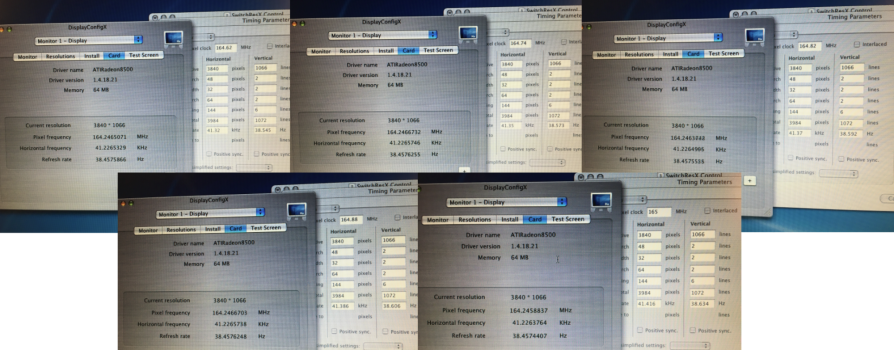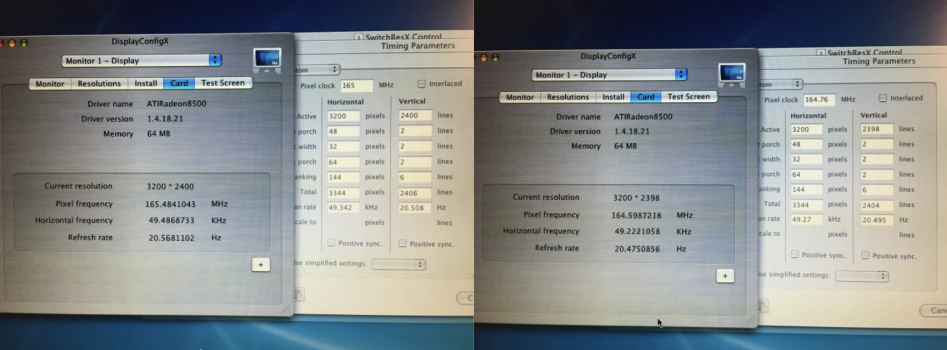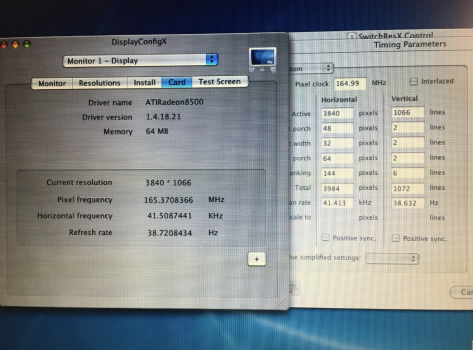297 MHz is 2.97 Gbps only if it's doing 10bpp or (8bpp using 8b/10b encoding).
Yup.
165MHz * 24bpp = 3.96 Gbps
* 1/8b/10b = 4.95 Gbps.
24bpp is 8bpc 3cpp while 8bpp is gray-scale (8bpc 1cpp)?
Or what if the 2.97 Gbps were per TMDS line? There's 3 TMDS lines. One per component.
The manual says 2.97 Gbps per data pair. A data pair is a TMDS line (differential signalling requires two wires per TMDS line).
2.97 Gbps * 3 * 8b/10b = 7.128 Gbps.
7.128 Gbps / 24 bpp = 297 MHz.
The actual limit of HDMI 1.4 for 8bpc is 340 MHz.
297MHz is the HDMI pixel clock for 4K30. It is half of the HDMI pixel clock for 4K60 (594 MHz).
The limit of HDMI 2.0 for 8bpc is 600 MHz.
Thanks for this explanation! I didn't realize there were 3 TMDS lines in the signal, but that makes sense.
So (if I understand) the individual bandwidth of a single TMDS pair (8-bit channel) in a DVI-SL/HDMI 1.0 connection would be 1.32Gbps at 165MHz after encoding overhead.
--
I've gone back to testing with the 2008 MacBook Pro and the 2002 Titanium PowerBook.
It seems there were a couple things at play in my previous tests.
DisplayConfigX's interface requires even numbered intervals, so any attempt to enter 1, 1, 1 for vertical blanking becomes 2, 2, 2.
On the 2008 MacBook Pro using SwitchResX I can now set intervals 48, 32, 56; 1, 1, 1 and precisely the same modes work as did on the 62603 and A1306, albeit with a limit of 165.00 for SL and 330.00 for DL.
On the 2002 PowerBook using SwitchResX I can now set intervals of 48, 32, 56; 1, 1, 1, but the T221 flashes out of range and these do not work. An image is only produced after increasing the intervals to 48, 32, 64; 2, 2, 2.
Using SwitchResX to test the OSD's refresh rounding point (2002 TiBook; DVI-SL):
Using an arbitrary test case of 3840 x 1068 @ 38.497 Hz (164.72 MHz) and 3840 x 1066 @ 38.503 Hz (164.44 MHz,) both modes display '38 Hz' on the OSD (though Mac OS considers the latter 39 Hz in the UI.) [48, 32, 64; 2, 2, 2]
Increasing the clock of the 1066 resolution until '39 Hz' is displayed (rebooting between each setting):
164.62 MHz (38.545 Hz) = '38 Hz'
164.74 MHz (38.573 Hz) = '38 Hz'
164.82 MHz (38.592 Hz) = '38 Hz'
164.88 MHz (38.606 Hz) = '38 Hz'
165.00 MHz (38.634 Hz) = '38 Hz'
Since the TiBook's Radeon output timings can be directly monitored by DisplayConfigX, I've spot checked and discovered that none of these small adjustments actually affect the card's output at all. It never exceeds 164.247 MHz. So the T221's scaler is reading the signal accurately, and Mac OS is reading accurately what SwitchResX is specifying in the override, but the Radeon doesn't explicitly obey the override's timings.

Yet, in other modes, the Radeon seems happy to actually step over the 165 MHz bound, even though the software can't instruct it to.

Since that didn't work, I'll then try making an attempt to slow down the 3200 x 2400 resolution, since it's just over the .5 mark and the OSD does indicate 21 Hz.
3200 x 2400 @ 165.00 MHz = 20.508 MHz ('21 Hz' on OSD)
3200 x 2398 @ 164.76 MHz = 20.495 MHz ('20 Hz' on OSD)
So this one works just as expected on the first try, though the gap is much larger between the two in the DCX readings.

Now that the 3840 x 1066 mode has been removed for a reboot cycle, I'll re-add it at 165.00 MHz:
And now the OSD shows 39 Hz and DCX shows 165.37 MHz.
So basically altering an existing resolution in this version of the software doesn't actually change the override unless the machine is booted with the resolution completely removed and then added fresh and rebooted again. Good to know I guess; I'll keep this in mind and re-test everything from a blank slate before I record any limits data with SRX on the TiBook.

...I'm still inclined to trust the OSD; it's never disagreed with the numbers DisplayConfigX has read out from the Radeon. Unfortunately the 2008's 8600M GT doesn't allow DCX to read live timing data.
What adapters are they/what chipset do they use?
Finally got the last casing open. ...another Lontium LT6711A? I wonder why it doesn't do the same thing as the other one. Now I have a Club3D '8K' DisplayPort cable instead of a no-name, but it still just sends all connected displays into an endless loop of redetecting whenever it's plugged into the TH2G Digital SE...
Neat. I think perhaps just a generalized section with an overview of all the derivatives makes the most sense. Prototypes, siblings, offshoots, related feature-sets...
Or maybe a 'displays' parent page which the Bertha page can be listed on.










